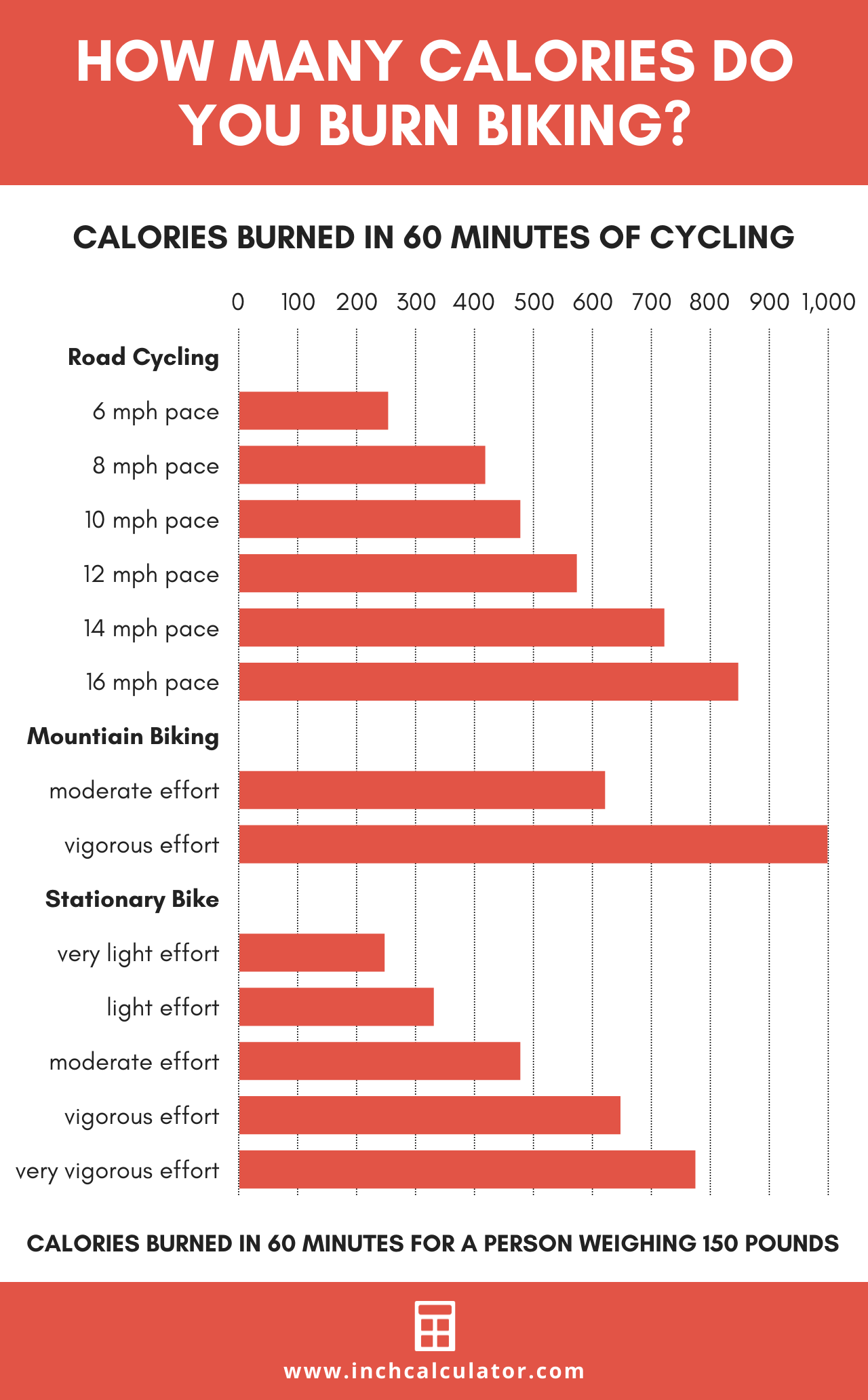Calories Burned Biking Calculator
Calculate the calories you burn biking given your body weight, cycling intensity, and duration.
Calories Burned Biking:
Total Calories
Calories per Hour
On this page:
How Many Calories Does Biking Burn?
Biking is a great cardio and strength-building exercise that can burn a significant number of calories. Another great thing about biking, or cycling, is that it can take on many forms.
You can burn a high number of calories riding your bike down the road, mountain biking over trails, or taking Spin classes at your gym.
Along with burning calories and helping you maintain a healthy weight, biking also has many health benefits, including a lower risk of cardiovascular disease and diabetes.
Plus, cycling is considered to be a low impact activity, meaning it is more gentle on your joints than running or sports that involve jumping. This decreases the risk of injury or putting unnecessary stress on your joints.
The amount of calories you burn will vary depending on the workout, intensity, duration of work, and your body weight. The following chart shows approximately how many calories a typical 150-pound person would burn during various 60-minute cycling workouts.
| Intensity | Calories Burned in 60 Minutes |
|---|---|
| Road Cycling | |
| 6 mph pace | 250 calories |
| 8 mph pace | 415 calories |
| 10 mph pace | 485 calories |
| 12 mph pace | 570 calories |
| 14 mph pace | 715 calories |
| 16 mph pace | 850 calories |
| Mountain Biking | |
| moderate effort | 610 calories |
| vigorous effort | 1000 calories |
| Stationary Bike (Spin) | |
| very light effort | 250 calories |
| light effort | 345 calories |
| moderate effort | 485 calories |
| vigorous effort | 630 calories |
| very vigorous effort | 785 calories |

How to Calculate Calories Burned
You can get an estimate of the calories you burn from biking by using a MET calculator like the one above. When you add your calories burned through your cycling workouts to your basal metabolic rate, you can estimate how many calories you should consume each day to match your energy output.
You can also estimate calories burned using the same formulas that a MET calculator uses in a few easy steps.
Find the MET Value
To calculate calories burned during biking, you first need to determine the MET value based on the intensity of your cycling session. This will be based on both the intensity of your bike workouts and the form of biking you perform.
A MET, or metabolic equivalent of a task, is the energy burned during an activity that is expressed as a standardized number. For example, one MET would be how much energy you expend while sitting quietly; six METs would be over six times this amount of energy, which would be a vigorous activity.
There is a MET value for nearly every type of physical activity. These numbers are a ratio of the metabolic rate during that specific exercise compared to the metabolic rate at rest.
This is also defined as the amount of oxygen consumed while exercising compared to sitting at rest; this is necessary, since your muscles need that oxygen in order to effectively move your body.
The MET associated with your resting metabolic rate is equivalent to the amount of oxygen you burn at rest. This is estimated to be about 3.5 milliliters of oxygen per kilogram of body weight per minute, which is equivalent to one MET.[1]
As you exercise, you consume more oxygen. This means more intense activities have MET values above one.
METs are a simple way to estimate how many calories you burn during a number of different physical activities and exercises, including biking. A complete list can be found in the Compendium of Physical Activities.[2]
Calories Burned Biking Formula
Once you determine the effort of your bike session, you can use the MET value to determine how many calories you will burn based on the amount of time spent cycling at that pace.
calories burned = time [min] × (MET × 3.5) × weight [kg] / 200
MET Values for Biking and Cycling
From this table, you can see that when you increase the intensity and bike at a higher effort, more energy is expended, and more calories are burned.
| Bike Effort | MET Value |
|---|---|
| General Biking Outdoors | |
| Leisurely/Low Effort | 3.5 – 6.8 |
| Moderate Effort | 8.0 – 10.0 |
| Vigorous Effort | 10.0 – 15.8 |
| Mountain Biking | |
| Moderate Effort | 8.5-14.0 |
| Vigorous Effort | 14.0-16.0 |
| Stationary Bike | |
| Low Effort | 3.5-4.8 |
| Moderate Effort | 4.8-6.8 |
| Vigorous Effort | 6.8-11.0 |
Even for the same effort, you can actually burn more calories mountain biking as compared to stationary biking. This is because mountain biking typically requires a greater effort as you navigate trails and hills.
Research has even found that downhill mountain biking has a positive correlation effect on the physiological demands of the body, which can improve several components of health and wellness.[3] This explains the slightly higher caloric expenditure as well.
For example, if a 140-pound woman is mountain biking at a vigorous effort for 30 minutes, she will burn:
calories burned = 30 min × (14 × 3.5) × 140 ÷ 2.2 / 200
calories burned = 468 calories
If this same woman bikes at the same vigorous effort for 30 minutes on a stationary bike, she will burn:
calories burned = 30 min × (6.8 × 3.5) × 140 ÷ 2.2 / 200
calories burned = 227 calories
This illustrates how the form of biking, and not simply the effort, can impact caloric expenditure.
Spin Workouts
While mountain biking requires a high energy expenditure, stationary biking can also burn a considerable number of calories, especially during challenging workouts. For example, a study found that Spinning workouts provide a high heart rate response and high caloric expenditure in just a 40-minute cycling class.[4]
So even if you don’t have a road bike at home, you can still burn some serious calories doing Spin workouts on a stationary bike, especially during more vigorous sessions.
Biking To Burn Calories: Formal Exercise, Commuting, or a Leisurely Activity
Biking is an awesome activity that can be done as a leisurely ride with your family, an intense mountain biking ride along challenging trails, or even as a vigorous spin class at your gym. In addition, biking can be a way to commute to work to burn calories and save money on gas!
Studies have discovered numerous health benefits from those choosing to cycle commute to work. In one 2017 study, biking to work was linked to a decreased risk of developing heart disease as well as cancers.[5]
Commuting to work is just one more way to add exercise into your day to increase physical activity and burn more calories.
From intense outdoor or indoor bike workouts to leisurely rides with friends, cycling is a great way to burn calories, improve your overall health, and have fun all at the same time.
This biking calorie calculator will help you estimate how many calories you burn based on the effort of your workout sessions and the form of cycling that you perform.
References
- Jetté, M., Sidney, K., & Blümchen, G., Metabolic equivalents (METS) in exercise testing, exercise prescription, and evaluation of functional capacity, Clinical Cardiology, 1990, 13(8), 555–565. https://doi.org/10.1002/clc.4960130809
- Ainsworth BE, Haskell WL, Herrmann SD, Meckes N, Bassett Jr DR, Tudor-Locke C, Greer JL, Vezina J, Whitt-Glover MC, Leon AS., The Compendium of Physical Activities Tracking Guide, Healthy Lifestyles Research Center, College of Nursing & Health Innovation, Arizona State University, https://pacompendium.com/
- Burr, J. F., Drury, C. T., Ivey, A. C., & Warburton, D. E., Physiological demands of downhill mountain biking, Journal of Sports Sciences, 2012, 30(16), 1777-1785. https://www.tandfonline.com/doi/abs/10.1080/02640414.2012.718091
- Falsetti, H., Blau, S., Burke, E., & Smith, K., Heart rate response and calories burned in a spinning® workout, Spinning® Instructor Manual. Venice, Italy: Mad Dogg Athletics, Inc, 2010, B1, https://static1.squarespace.com/static/5e3d4b081f37797fb4240a5b/t/5e622c4e7049210ba4df407c/1583492175682/Heart_Rate_Calories_Burned.pdf
- Celis-Morales, C. A., Lyall, D. M., Welsh, P., Anderson, J., Steell, L., Guo, Y., Maldonado, R., Mackay,D., Pell,J., Sattar, N., & Gill, J. M., Association between active commuting and incident cardiovascular disease, cancer, and mortality: prospective cohort study, BMJ, 2017, 357, j1456. https://www.bmj.com/content/bmj/357/bmj.j1456.full.pdf


